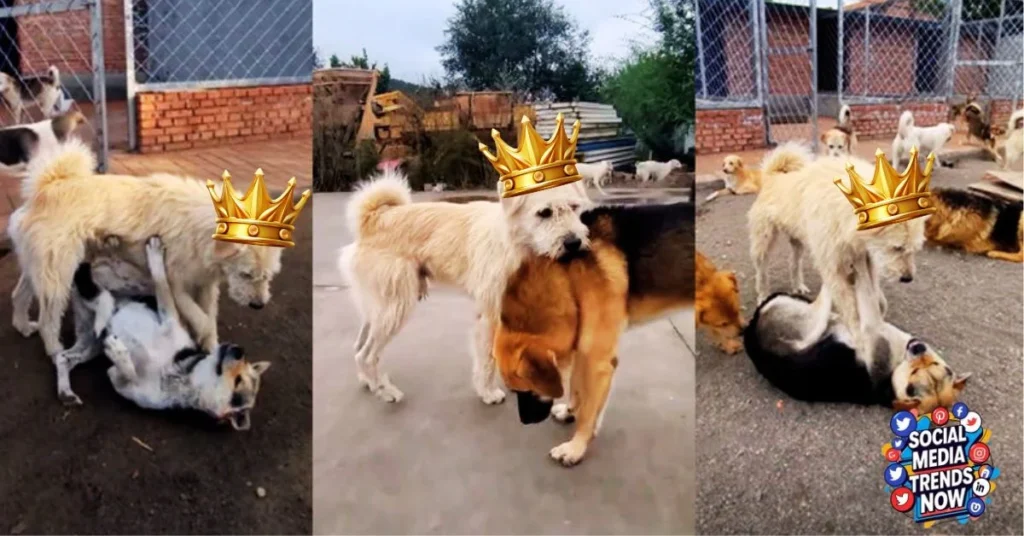In a busy dog shelter in Hebei Province, China, a white, long-haired dog captured hearts with nothing more than a calm gaze and a gentle paw. Nicknamed King Charles by fans around the world, he became an internet sensation overnight by peacefully restoring order among restless shelter mates. Instead of barking or growling, King Charles simply approached a rowdy dog and placed his paw on its chest or back, immediately calming the chaos around him. When that moment was captured on video and shared by Shine.cn, it set off a global fascination with his leadership style.
His story is proof that leadership does not require force—only confidence and composure. From that pivotal video, King Charles became a symbol of non-violent authority, sparking discussions about canine behavior and the potential of shelter dogs everywhere.
Breed Heritage: The Xiasi Dog’s Storied Past
King Charles is not a King Charles Spaniel—rather, he is a Xiasi Dog (下司犬), an ancient breed from Guizhou Province in southwest China. This breed, prized for speed, endurance, and strong territorial instincts, was traditionally kept by the Miao communities to protect homes and track prey through mountainous terrain. Their lean bodies, pure white coats, and alert expressions are hallmarks of a lineage that has existed for over a thousand years, yet remained relatively unknown beyond China’s borders until King Charles’s rise to fame.
Local lore claims the breed’s name dates back to the Qing Dynasty. When an official presented a Xiasi Dog to Emperor Qianlong, the emperor was so impressed by its bravery that he inquired about the breed. To avoid offending the sovereign, who was referred to as a “true dragon,” the official respectfully called it a “Xiasi Dog” rather than its local “white dragon dog” nickname. From then on, the name stuck. Although numbers have dwindled in recent decades, enthusiasts are now working to preserve the Xiasi line, buoyed by King Charles’s unexpected global recognition.
Early Life and Rescue: From Streets to Safety
Before his online fame, King Charles’s life mirrored that of many shelter dogs: uncertainty and hardship. He was found as a stray in northern China, brought to a shelter in Hebei, and cared for by volunteers. There, he became part of the community documented by a Douyin account called “Bearded Uncle’s Dog Tribe,” run by a hobbyist who raises and films shelter dogs. It was on this platform that King Charles’s unique presence first caught the attention of viewers.
Through that account, shelter staff and volunteers noted his calm demeanor. Even among dozens of barking and anxious dogs, he rarely seemed ruffled. His habit of stepping toward squabbling dogs and placing a single paw on their shoulders to halt conflicts became a crowd favorite. That moment of peaceful dominance was the catalyst for his transformation from an anonymous shelter canine to a global “alpha dog.”
Personality and Behavior: Calm, Confident, Compassionate
What sets King Charles apart is not merely his looks but his emotional intelligence. He possesses an uncanny ability to sense tension among other dogs and defuse it with minimal effort. When a fight breaks out, he does not bark or push aggressively; he simply walks into the fray, pauses, and rests his paw on whichever dog is causing trouble. Almost like a mediator, his presence alone diffuses hostility, and once calm is restored, he retreats without fanfare.

Observers liken his aura to that of a monk walking into a noisy marketplace—everything hushes in his wake. While most dogs rely on size, speed, or vocalization to maintain order, King Charles’s approach is purely psychological: a demonstration of unshakable self‐assurance. That quiet confidence has led many trainers and behaviorists online to discuss his technique as a case study in canine leadership.
Viral Sensation: From Douyin to Global Screens
The original footage of King Charles appeared on Douyin, China’s TikTok equivalent, under “Bearded Uncle’s Dog Tribe.” As viewers witnessed his gentle pawing technique to diffuse conflicts, shares multiplied rapidly. Soon, YouTube channels such as The Apex Canines remixed the clips into documentary‐style shorts, complete with dramatic music and voice‐over commentary. That version alone amassed tens of millions of views across YouTube, TikTok, and X (formerly Twitter), propelling King Charles to international stardom in a matter of days.
Celebrities, pet influencers, and mainstream media outlets worldwide picked up the story. News segments described him as a “symbol of non‐violent conflict resolution,” while social platforms were flooded with memes, fan art, and hashtags celebrating “King Charles the Alpha Dog.” His calm, regal bearing contrasted sharply with the usual viral dog antics, making his videos especially shareable and memorable.
Fan Community and Cultural Impact
Within weeks, an enthusiastic fan community sprang into existence. Social media users began giving nicknames to shelter dogs based on their perceived personalities—“Thorne” for a black pup, “Wick” for a German shepherd, and “Tyrant” for a former pack leader. Rumors circulated that King Charles and Tyrant were siblings, with online speculation fueling dramatic fan theories about a “power struggle” between them. While most of these stories were playful fiction, they underscored how deeply people connected with a humble shelter dog.
Beyond memes, merchandise exploded: T‐shirts emblazoned with King Charles’s silhouette appeared on Instagram, children’s books were written in his honor, and even a tongue‐in‐cheek parody cryptocurrency emerged—“AlphaCoin.” Fan communities posted reenactments of his signature paw move, complete with slow‐motion dramatics and theatrical music. His calm dominance resonated as a lesson in leadership for humans as well, prompting online discussions about stress reduction, conflict resolution, and emotional intelligence.
Health and Care: The Senior Guardian
Now about eleven years old, King Charles is well into his senior years—an advanced age for a medium‐sized Xiasi Dog. Volunteers revealed that he is blind in one eye and losing vision in the other, yet his calm confidence remains unwavering. Despite limited eyesight, he still navigates the shelter with grace, relying on memory and scent to move among other dogs.
At an older age, Xiasi Dogs can be prone to joint stiffness and vision issues, so shelter volunteers ensure he get gentle exercise and wheelchair support if needed. His diet includes joint supplements and high‐protein kibble to maintain muscle mass. Though his days of chasing wild boar are long behind him, King Charles continues to serve as pack guardian, calmly overseeing new arrivals and helping them adjust to shelter life.
Broader Impact: Advocacy for Shelter Dogs and Breed Preservation
King Charles’s viral fame has done more than entertain—it has changed perceptions of shelter dogs and bolstered efforts to preserve the Xiasi breed. Adoption applications at the Hebei shelter spiked as people from across China and abroad inquired about fostering or adopting an Xiasi Dog. Even though King Charles currently remains at the shelter as its ambassador, his fame has generated donations for better kennel facilities, medical care, and rescue operations.
Meanwhile, breed enthusiasts are using his story to highlight the Xiasi Dog’s rich heritage. Conservation groups in Guizhou Province have reported renewed interest from amateur breeders and cultural historians aiming to protect the lineage. Some have organized Xiasi Dog festivals featuring traditional hunting demonstrations, while others fund genetic research to document and preserve breed characteristics. Though once on the brink of obscurity, the Xiasi Dog is experiencing a renaissance thanks to its most famous living ambassador.
Key Takeaways
-
Humble Beginnings: King Charles was discovered as a stray and brought to a Hebei shelter, where his peaceful authority shone.
-
Breed Heritage: As an Xiasi Dog, he represents a thousand‐year‐old Chinese hunting and guard lineage once reserved for Miao communities.
-
Calm Leadership: Rather than using aggression, he diffuses conflicts with a single gentle paw, proving that true leadership lies in confidence and composure.
-
Viral Influence: From Douyin to YouTube, his story garnered tens of millions of views, inspiring fan art, merchandise, and lessons in leadership for humans and dogs alike.
-
Advocacy Outcomes: His fame has increased adoptions, spurred donations, and revitalized efforts to preserve the Xiasi Dog breed.
FAQs
What breed is King Charles?
King Charles is a Xiasi Dog, an ancient hunting and guard breed originating in Guizhou Province, China.
How did King Charles gain his “alpha dog” reputation?
He became famous after videos showed him calmly placing his paw on other dogs to stop fights, demonstrating non‐violent leadership.
Where is King Charles now?
He still resides at the Hebei shelter where he was rescued, serving as an ambassador for adoption and Xiasi Dogs.
How old and healthy is King Charles?
He is around 11 years old and is blind in one eye while losing vision in the other. Despite his age and sight limitations, he remains a calming presence for other dogs.
How can I help Xiasi Dogs like King Charles?
You can support by donating to shelters in Hebei, following protection and breeding programs in Guizhou, and spreading awareness about this unique breed.


